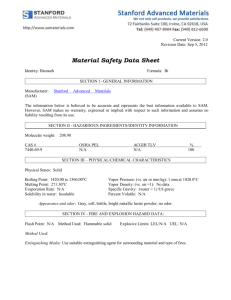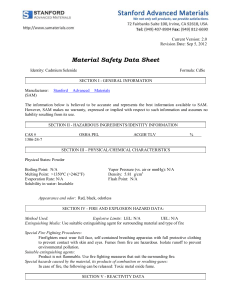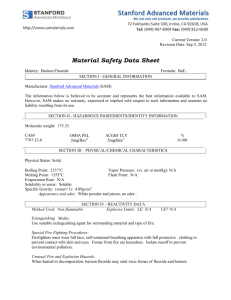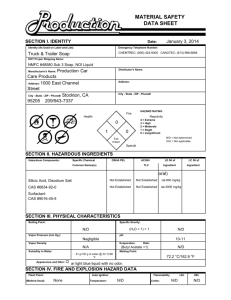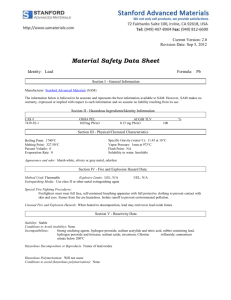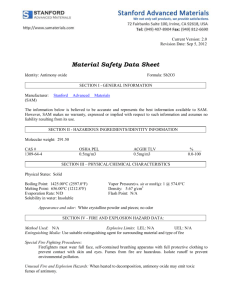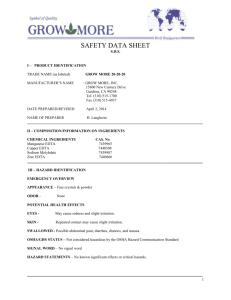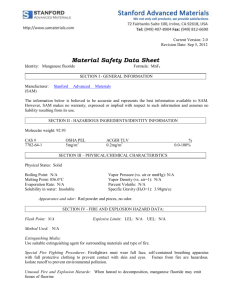Microsoft Word - Cd - Stanford Advanced Materials
advertisement
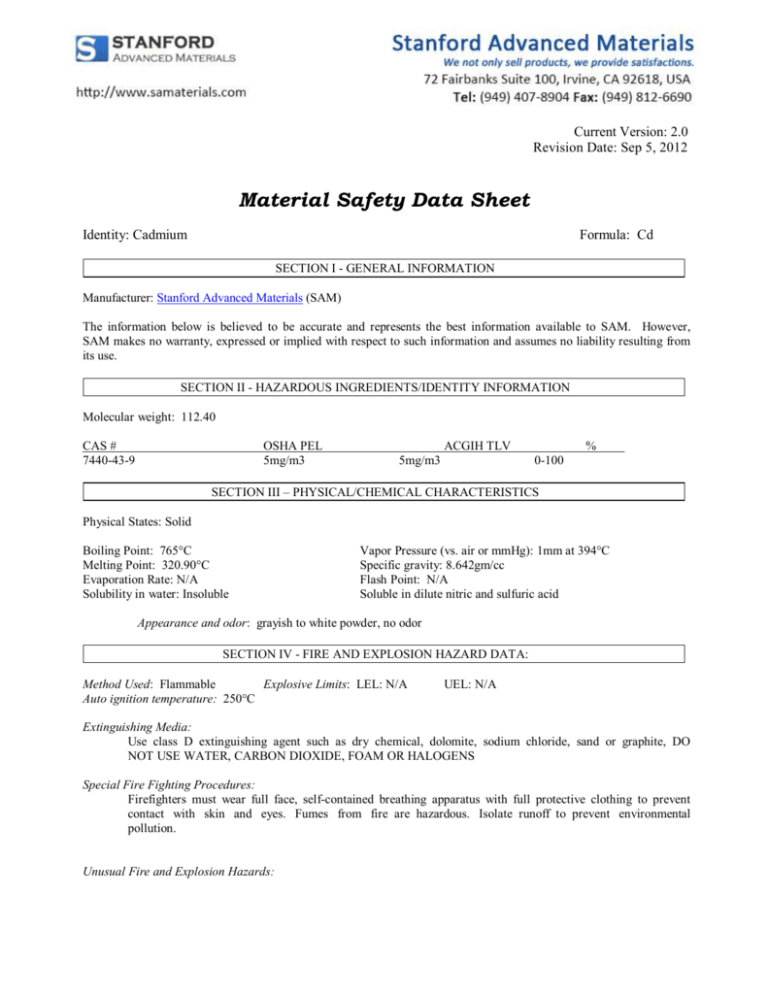
Current Version: 2.0 Revision Date: Sep 5, 2012 Material Safety Data Sheet Identity: Cadmium Formula: Cd SECTION I - GENERAL INFORMATION Manufacturer: Stanford Advanced Materials (SAM) The information below is believed to be accurate and represents the best information available to SAM. However, SAM makes no warranty, expressed or implied with respect to such information and assumes no liability resulting from its use. SECTION II - HAZARDOUS INGREDIENTS/IDENTITY INFORMATION Molecular weight: 112.40 CAS # 7440-43-9 OSHA PEL 5mg/m3 ACGIH TLV 5mg/m3 % 0-100 SECTION III – PHYSICAL/CHEMICAL CHARACTERISTICS Physical States: Solid Boiling Point: 765°C Melting Point: 320.90°C Evaporation Rate: N/A Solubility in water: Insoluble Vapor Pressure (vs. air or mmHg): 1mm at 394°C Specific gravity: 8.642gm/cc Flash Point: N/A Soluble in dilute nitric and sulfuric acid Appearance and odor: grayish to white powder, no odor SECTION IV - FIRE AND EXPLOSION HAZARD DATA: Method Used: Flammable Explosive Limits: LEL: N/A Auto ignition temperature: 250°C UEL: N/A Extinguishing Media: Use class D extinguishing agent such as dry chemical, dolomite, sodium chloride, sand or graphite, DO NOT USE WATER, CARBON DIOXIDE, FOAM OR HALOGENS Special Fire Fighting Procedures: Firefighters must wear full face, self-contained breathing apparatus with full protective clothing to prevent contact with skin and eyes. Fumes from fire are hazardous. Isolate runoff to prevent environmental pollution. Unusual Fire and Explosion Hazards: When heated to high temperatures, cadmium may emit toxic fumes. Dust-air mixtures may be explosive. Finely divided metal may be pyrophoric in air. Flammable by chemical reaction with oxidizing agents, metals, ammonia, zinc, selenium, or tellurium. May be hazard when exposed to ammonium nitrate and hydrozoic acid. Contact with acids may form flammable hydrogen gas. SECTION V - REACTIVITY DATA Stability: Stable Conditions to Avoid (stability): None Incompatibility: Strong oxidizers, elemental sulfurs, ammonia, zinc, selenium, tellurium metals, acids, ammonium nitrate, hydrozoic acid and nitryl fluoride Hazardous Decomposition or Byproducts: Airborne cadmium fumes, cadmium oxide, and hydrogen gas Hazardous Polymerization: Will not occur Conditions to avoid (hazardous polymerization): None SECTION VI - HEALTH HAZARD DATA Signs and Symptoms of Overexposure: Inhalation: Throat dryness, cough, headache, vomiting, chest pain, extreme restlessness and irritability, pneumonitis, possible bronchiopneumonia Ingestion: Increased salivation, choking, vomiting, abdominal pain, anemia, renal dysfunction, diarrhea, and tenesmus Skin: Redness, itching, swelling and/or burning Eye: Redness, itching, watering and/or burning Health Hazards (Acute and Chronic): Cadmium compounds are confirmed carcinogens producing lung tumors. Poison by ingestion Inhalation: Acute: Highly toxic. May cause irritation to upper respiratory tract, rhinitis, vertigo, constriction or the throat, metallic taste, cough, dyspnea, cyanosis, chest pain, flu-like symptoms and pulmonary edema. Chronic: May cause irreversible lung injury, pulmonary fibrosis, damage to olfactory nerve, kidney damage, osteomalacia, osteoporosis, spontaneous fracture, hemolytic and iron deficiency anemia, weight loss, irritability, renal tubular necrosis, cardiovascular effects, liver damage, prostate and respiratory cancers. Ingestion: Acute: Chronic: May cause irritation of mouth and throat, increased salivation, burning sensation, cramps, nausea, headache and vomiting, weakness, dizziness, diarrhea, shock, convulsions May cause irreversible renal tubular dysfunction, functional changes in the liver, pancreas and adrenal glands Skin: Acute: Chronic: May cause irritation Prolonged exposure may result in dermatitis Eye: Acute: May cause irritation Chronic: Prolonged exposure may cause conjunctivitis Target Organs: Respiratory system, kidneys, prostate and blood Carcinogenicity: NTP? Yes IARC Monographs? Yes OSHA Regulated? Yes Medical Conditions Aggravated by Exposure: Kidney or respiratory dysfunction, blood or bone disorders Emergency and First Aid Procedures: Inhalation: Remove victim to fresh air, keep warm and quiet, and give oxygen if breathing is difficult; seek medical attention Ingestion: Give 1-2 glasses of milk or water and seek medical attention. Never induce vomiting or give anything by mouth to an unconscious person Skin: Remove contaminated clothing, brush material off skin, wash affected area with mild soap and water, and seek medical attention if symptoms persist Eye: Flush eyes with lukewarm water, lifting upper and lower eyelids for at least 15 minutes and seek medical attention SECTION VII - PRECAUTIONS FOR SAFE HANDLING AND USE Steps to be taken in case material is released or spilled: Wear appropriate respiratory and protective equipment specified in section VIII. Isolate spill area, provide ventilation and extinguish sources of ignition. Vacuum up spill using a high efficiency particulate absolute (HEPA) air filter and place in a closed container for proper disposal. Take care not to raise dust. Waste disposal method: Dispose of in accordance with state, local, and federal regulations. Hazard Label Information: Use chemical splash goggles, avoid creating dust, can cause kidney and lung disease Wash thoroughly after handling. SECTION VIII - CONTROL MEASURES Protective Equipment Summary (Hazard Label Information): NIOSH approved respirator, impervious rubber gloves, safety glasses, clothes to prevent contact. Ventilation: Local Exhaust: To maintain concentration at low exposure levels. Mechanical (General): NOT Recommended. Other: Enclose process if possible Work/Hygienic/Maintenance Practices: Implement engineering and work practice controls to reduce and maintain concentration of exposure at low levels. Use good housekeeping and sanitation practices. Do not use tobacco or food in work area. Wash thoroughly before eating or smoking. Do not blow dust off clothing or skin with compressed air. Please be advised that N/A can either mean Not Applicable or No Data Has Been Established
